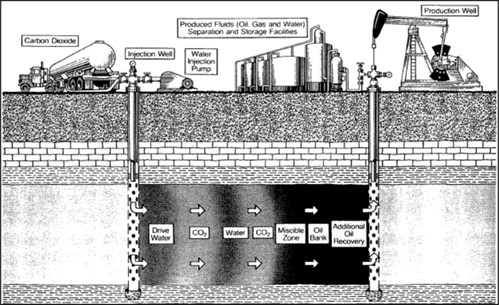Depleted(hydrocarbon reservoir) one where production is significantly reduced or depleting hydrocarbon fields usually have a long production record and come with a great deal of knowledge about their geometry and reservoirA subsurface body of rock with sufficient porosityMeasure for the amount of pore spaceSpace between rock or sediment grains that can contain fluids in a rock and permeabilityAbility to flow or transmit fluids through a porous solid such as rock to store and transmit fluids properties. These are proven storage(CO2Carbon dioxide) A process for retaining captured CO2Carbon dioxide, so that it does not reach the atmosphereThe layer of gases surrounding the earth; the gases are mainly nitrogen (78%) and oxygen (around 21%) sites because the hydrocarbon fields are traps by definition. It is difficult to define criteria for the usability of depleted(hydrocarbon reservoir) one where production is significantly reduced gas fields for CO2Carbon dioxide geological storage(CO2Carbon dioxide) A process for retaining captured CO2Carbon dioxide, so that it does not reach the atmosphereThe layer of gases surrounding the earth; the gases are mainly nitrogen (78%) and oxygen (around 21%) - certainly bigger fields are better suited for this purpose, but an economic scenarioA plausible description of the future based on an internally consistent set of assumptions about key relationships and driving forces; note that scenarios are neither predictions nor forecasts together with CO2Carbon dioxide availability are also required. The issue of enhanced hydrocarbon recovery is clearer, especially in the case of CO2Carbon dioxide-EOREnhanced Oil RecoveryThe recovery of oil additional to that produced naturally, achieved by fluid injection or other means: the recovery of oil additional to that produced naturally, achieved by fluid injection or other means (Vangkilde-Pedersen et al., 2008) where miscible flood(reservoir) The injection of a fluid into an underground reservoir (Fig. 2-3), ensuring a high (additional) recovery, is preferred.
 Fig. 2-3: CO2Carbon dioxide-EOREnhanced Oil RecoveryThe recovery of oil additional to that produced naturally, achieved by fluid injection or other means: the recovery of oil additional to that produced naturally, achieved by fluid injection or other means miscible flood(reservoir) The injection of a fluid into an underground reservoir process (Green and Willhite, 19981998 - D. W. Green and G. P. WillhiteEnhanced Oil Recoverysee more). |
Tab. 2-2 presents the most commonly applied CO2Carbon dioxide-EOREnhanced Oil RecoveryThe recovery of oil additional to that produced naturally, achieved by fluid injection or other means: the recovery of oil additional to that produced naturally, achieved by fluid injection or other means criteria (after Taber et al., 19971997 - J. J. Taber, F. D. Martin and R. S. SerightEOR Screening Criteria Revisited - Part 2: Applications and Impact of Oil Pricessee more). Conditions for miscible flood(reservoir) The injection of a fluid into an underground reservoir (mixture of oil and CO2Carbon dioxide appears close to the injectionThe process of using pressure to force fluids down wells front causing a relative high pressure build-up in surroundings) are defined for a wide range of oil types and reservoirs, with the exception of heavy oils, for which immiscible flood(reservoir) The injection of a fluid into an underground reservoir applies. In the case of heavy oils, the CO2Carbon dioxide-EOREnhanced Oil RecoveryThe recovery of oil additional to that produced naturally, achieved by fluid injection or other means: the recovery of oil additional to that produced naturally, achieved by fluid injection or other means mechanism is the buoyancyTendency of a fluid or solid to rise through a fluid of higher density force, not unlike as in the saline aquifers; however, this is less effective and less profitable than the miscible flood(reservoir) The injection of a fluid into an underground reservoir.
| Tab. 2-2: CO2Carbon dioxide Flooding (Enhanced Oil RecoveryThe recovery of oil additional to that produced naturally, achieved by fluid injection or other means) criteria proposed by Taber et al., 19971997 - J. J. Taber, F. D. Martin and R. S. SerightEOR Screening Criteria Revisited - Part 2: Applications and Impact of Oil Pricessee more. | Criterion/ Mechanism | Oil gravity [APIAmerican Petroleum Institute; degree API is a measure of oil density] (current projects) | Depth | Composition | Viscosity [cP] (current projects) | Oil saturation [% PV] (current projects) | ReservoirA subsurface body of rock with sufficient porosityMeasure for the amount of pore spaceSpace between rock or sediment grains that can contain fluids in a rock and permeabilityAbility to flow or transmit fluids through a porous solid such as rock to store and transmit fluids formationA body of rock of considerable extent with distinctive characteristics that allow geologists to map, describe, and name it | Average permeabilityAbility to flow or transmit fluids through a porous solid such as rock | | Miscible flood(reservoir) The injection of a fluid into an underground reservoir | >40 32 - 39.9 28 - 31.9 22 - 27.9 (27 - 44) | >830 m >930 m >1100 m > 1330 m | High percentage of intermediate hydrocarbons (especially C5 - C12) | <10 (0.3 - 6) | >20 (15 - 70) | Sandstones or carbonates; relatively thin unless dipping | Sufficient injectionThe process of using pressure to force fluids down wells rates maintained | | Immiscible flood(reservoir) The injection of a fluid into an underground reservoir | 13-22 | >600 m | | | | | | |